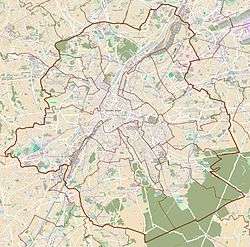Belgian Comic Strip Center
| Centre belge de la Bande dessinée/Belgisch Stripcentrum | |
 Location within Brussels | |
| Established | October 6, 1989[1] |
|---|---|
| Location |
Rue des Sables/Zandstraat 20 B-1000 Brussels |
| Coordinates | 50°51′04″N 4°21′36″E / 50.851111°N 4.36°E |
| Type | History of Belgian comics |
| Visitors | More than 200,000 per year[1] |
| Public transit access | Brussels-Central |
| Website |
www |
The Belgian Comic Strip Center (French: Centre belge de la Bande dessinée, Dutch: Belgisch Stripcentrum) is a museum in Brussels, located in the Rue des Sables /Zandstraat 20, dedicated to Belgian comics.
History of the building
The building was designed in 1905 by world-famous architect Victor Horta in Art Nouveau style and served as textile department store, the Magasins Waucquez. After Waucquez's death in 1920, the building began to languish away and in 1970 the firm closed its doors. Jean Delhaye, a former aid of Horta, saved the building from demolition and by October 16, 1975 it was acknowledged as a protected monument. Still, the building was in bad shape and victim of a lot of vandalism.[2]
In 1980 architect Jean Breydel and comics artists François Schuiten, Bob de Moor, Alain Baran, Guy Dessicy and Hergé planned to restore the building and give it a new destination as a museum dedicated to the history of Belgian comics. Originally the museum would be a homage to Hergé, but he himself suggested honoring the entire Belgian comics industry. In 1983 Belgian Minister of Public Works Louis Olivier decided that the building would be bought by the Direction of Buildings, making it national property.[2] In 1984 a fund was founded which united several Flemish and Walloon comics artists. Two years later the restorations began, with respect for the original architecture while updating it to modern standards. The mozaik was flown over from Italy and constructed by Italian mozaik workers, because the profession had become obsolete in Belgium.[2]
On October 6, 1989 the museum was inaugurated in the presence of king Baudouin of Belgium and queen Fabiola of Belgium.[3]
In the fall of 2015 the museum started redecorating its permanent exhibition.[4]
The museum
On the ground floor of the museum a restaurant can be found, a room dedicated to Victor Horta, a comics' store named "Slumberland" after Little Nemo in Slumberland,[5] a library with a reading room and study center. The first floor has an auditorium, a room with original comic book pages by various artists and a room dedicated to animation, more specifically the Belgian animation industry, such as Belvision.[2]
The second floor has a permanent exhibition dedicated to the chronological history of the medium in Belgium called "The Museum of Imagination".[5] The exhibit starts off with Hergé and ends with Peyo, covering the pioneers of Belgian comics between 1929 and 1958 and with special focus on the magazines Spirou and Tintin. Each artist has a room dedicated to his work and designed in a playful way.[2][6]
The final floor is dedicated to the merchandising of comics and available for provisional exhibitions.[2]
List of the exhibited comics artists
Four artists exhibited are Flemish, Willy Vandersteen, Marc Sleen, Bob de Moor and Morris. The rest are Walloon, except for Jacques Martin and Tibet who were born in France, but published in Tintin.
- Hergé - (The Adventures of Tintin, Quick and Flupke, Jo, Zette and Jocko)
- Jijé - (Spirou et Fantasio, Jerry Spring)
- Edgar P. Jacobs - (Blake and Mortimer)
- Willy Vandersteen - (Suske en Wiske)
- Marc Sleen - (The Adventures of Nero)
- Maurice Tillieux - (Gil Jourdan)
- Bob De Moor - (Cori, de Scheepsjongen)
- André Franquin - (Spirou et Fantasio, Marsupilami, Gaston Lagaffe, Franquin's Last Laugh)
- Jacques Martin - (The Adventures of Alix)
- Morris - (Lucky Luke)
- Paul Cuvelier - (Corentin)
- Victor Hubinon - (Buck Danny)
- Tibet - (Chick Bill, Ric Hochet)
- Raymond Macherot - (Chlorophylle, Sybilline)
- Jean Roba - (Boule et Bill)
- Peyo - (Johan and Peewit, The Smurfs)
Marc Sleen Museum
Since 2009, directly across the Belgian comics museum, in the same street, another comics-themed museum can be found, the Marc Sleen Museum, dedicated to the work of Marc Sleen.
Gallery
-

Exterior facade of the museum
-
Pannonceau
Rue Schtroumpf -
The shadow of Lucky Luke
-

Library
-

The staircase at the entrance
-

The main lighting of the building from the roof
-

Floor
-

Floor
-

Alternate view of the second floor
-

Entrance to the PUBLIART space
See also
- Brussels' Comic Book Route
- Billy Ireland Cartoon Library & Museum
- Fred Waring Cartoon Collection
- Michigan State University Comic Art Collection
References
- 1 2 "About Us—In Short". Brussels, Belgium: Belgian Comic Strip Center. Retrieved 4 July 2011.
- 1 2 3 4 5 6 http://www.tento.be/sites/default/files/tijdschrift/pdf/OKV1992/Belgisch%20Centrum%20van%20het%20Beeldverhaal%20Brussel.pdf
- ↑ http://www.brussels.be/artdet.cfm/6697
- ↑ http://www.stripmuseum.be/nl/tentoonstellingen/permanente-tentoonstellingen/de-hergeruimte
- 1 2 http://www.brusselsmuseums.be/en/museum/14-belgian-comic-strip-center
- ↑ "Drawing room: The Belgian Comic Strip Center: Tintin". The Independent. 15 October 2011. Retrieved 22 December 2012.
External links
| Wikimedia Commons has media related to Belgian Centre for Comic Strip Art. |
Coordinates: 50°51′04″N 4°21′36″E / 50.85111°N 4.36000°E